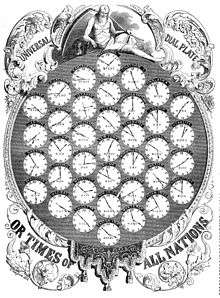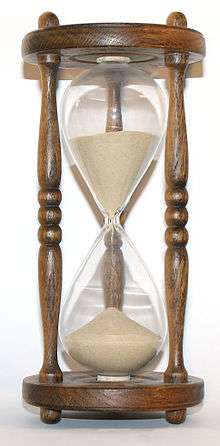Universal Time
Universal Time (UT) is a time standard based on Earth's rotation. There are several versions of Universal Time, which differ by up to a few seconds. The most commonly used are Coordinated Universal Time (UTC) and UT1 (see § Versions).[1] All of these versions of UT, except for UTC, are based on Earth's rotation relative to distant celestial objects (stars and quasars), but with a scaling factor and other adjustments to make them closer to solar time. UTC is based on International Atomic Time, with leap seconds added to keep it within 0.9 second of UT1.[lower-alpha 1]
Universal Time and standard time
Prior to the introduction of standard time, each municipality throughout the clock-using world set its official clock, if it had one, according to the local position of the Sun (see solar time). This served adequately until the introduction of rail travel in Britain, which made it possible to travel fast enough over long distances to require continuous re-setting of timepieces as a train progressed in its daily run through several towns. Greenwich Mean Time, the mean solar time on the Prime Meridian at Greenwich, England, was established to solve this problem: all clocks in Britain were set to this time regardless of local solar noon.[lower-alpha 2] Chronometers or telegraphy were used to synchronize these clocks.[3]

Standard time was originally proposed by Scottish-Canadian Sir Sandford Fleming at a meeting of the Canadian Institute in Toronto on 8 February 1879. He suggested that standard time zones could be used locally, but they were subordinate to his single world time, which he called Cosmic Time.[4] The proposal divided the world into twenty-four time zones, each one covering 15 degrees of longitude. All clocks within each zone would be set to the same time as the others, but differed by one hour from those in the neighboring zones. The local time at the Royal Observatory in Greenwich was announced as the recommended base reference for world time on 22 October 1884 at the end of the International Meridian Conference.[lower-alpha 3][5] This location was chosen because by 1884 two-thirds of all nautical charts and maps already used it as their prime meridian.[6] The conference did not adopt Fleming's time zones because they were outside the purpose for which it was called, which was to choose a basis for universal time (as well as a prime meridian).
During the period between 1848 and 1972, all of the major countries adopted time zones based on the Greenwich meridian.[7]
In 1935, the term Universal Time was recommended by the International Astronomical Union as a more precise term than Greenwich Mean Time, because GMT could refer to either an astronomical day starting at noon or a civil day starting at midnight.[8] In some countries, the term Greenwich Mean Time persists in common usage to this day in reference to civil timekeeping.
Measurement
Based on the rotation of the Earth, time can be measured by observing celestial bodies crossing the meridian every day. Astronomers found that it was more accurate to establish time by observing stars as they crossed a meridian rather than by observing the position of the Sun in the sky. Nowadays, UT in relation to International Atomic Time (TAI) is determined by Very Long Baseline Interferometry (VLBI) observations of distant quasars, a method which can determine UT1 to within 15 microseconds or better.[9][10]

The rotation of the Earth and UT are monitored by the International Earth Rotation and Reference Systems Service (IERS). The International Astronomical Union also is involved in setting standards, but the final arbiter of broadcast standards is the International Telecommunication Union or ITU.[11]
The rotation of the Earth is somewhat irregular and also is very gradually slowing due to tidal acceleration. Furthermore, the length of the second was determined from observations of the Moon between 1750 and 1890. All of these factors cause the modern mean solar day, on the average, to be slightly longer than the nominal 86,400 SI seconds, the traditional number of seconds per day.[lower-alpha 4] As UT is thus slightly irregular in its rate, astronomers introduced Ephemeris Time, which has since been replaced by Terrestrial Time (TT). Because Universal Time is determined by the Earth's rotation, which drifts away from more precise atomic-frequency standards, an adjustment (called a leap second) to this atomic time is needed since (as of 2019) 'broadcast time' remains broadly synchronised with solar time.[lower-alpha 5] Thus, the civil broadcast standard for time and frequency usually follows International Atomic Time closely, but occasionally step (or "leap") in order to prevent them from drifting too far from mean solar time.
Barycentric Dynamical Time (TDB), a form of atomic time, is now used in the construction of the ephemerides of the planets and other solar system objects, for two main reasons.[12] First, these ephemerides are tied to optical and radar observations of planetary motion, and the TDB time scale is fitted so that Newton's laws of motion, with corrections for general relativity, are followed. Next, the time scales based on Earth's rotation are not uniform and therefore, are not suitable for predicting the motion of bodies in our solar system.
Versions
There are several versions of Universal Time:
- UT0 is Universal Time determined at an observatory by observing the diurnal motion of stars or extragalactic radio sources, and also from ranging observations of the Moon and artificial Earth satellites. The location of the observatory is considered to have fixed coordinates in a terrestrial reference frame (such as the International Terrestrial Reference Frame) but the position of the rotational axis of the Earth wanders over the surface of the Earth; this is known as polar motion. UT0 does not contain any correction for polar motion. The difference between UT0 and UT1 is on the order of a few tens of milliseconds. The designation UT0 is no longer in common use.[13]
- UT1 is the principal form of Universal Time. While conceptually it is mean solar time at 0° longitude, precise measurements of the Sun are difficult. Hence, it is computed from observations of distant quasars using long baseline interferometry, laser ranging of the Moon and artificial satellites, as well as the determination of GPS satellite orbits. UT1 is the same everywhere on Earth, and is proportional to the rotation angle of the Earth with respect to distant quasars, specifically, the International Celestial Reference Frame (ICRF), neglecting some small adjustments. The observations allow the determination of a measure of the Earth's angle with respect to the ICRF, called the Earth Rotation Angle (ERA, which serves as a modern replacement for Greenwich Mean Sidereal Time). UT1 is required to follow the relationship
- UT1R is a smoothed version of UT1, filtering out periodic variations due to tides. It includes 62 smoothing terms, with periods ranging from 5.6 days to 18.6 years.[15]
- UT2 is a smoothed version of UT1, filtering out periodic seasonal variations. It is mostly of historic interest and rarely used anymore. It is defined by
- where t is the time as fraction of the Besselian year.[16]
- UTC (Coordinated Universal Time) is an atomic timescale that approximates UT1. It is the international standard on which civil time is based. It ticks SI seconds, in step with TAI. It usually has 86,400 SI seconds per day but is kept within 0.9 seconds of UT1 by the introduction of occasional intercalary leap seconds. As of 2016, these leaps have always been positive (the days which contained a leap second were 86,401 seconds long). Whenever a level of accuracy better than one second is not required, UTC can be used as an approximation of UT1. The difference between UT1 and UTC is known as DUT1.[17]
Adoption in various countries
The table shows the dates of adoption of time zones based on the Greenwich meridian, including half-hour zones.
|
|
Apart from Nepal Standard Time (UTC+05:45), the Chatham Standard Time Zone (UTC+12:45) used in New Zealand's Chatham Islands[19] and the officially unsanctioned Central Western Time Zone (UTC+8:45) used in Eucla, Western Australia and surrounding areas, all time zones in use are defined by an offset from UTC that is a multiple of half an hour, and in most cases a multiple of an hour.
See also
Notes
- The Earth's solar day is not constant.
- Despite its mandatory use on Great Western Railway stations from 1847 and thus widespread informal adoption, it was not until the Statutes (Definition of Time) Act 1880 that it became law.[2]
- Voting took place on 13 October.
- 24 hours of 60 minutes of 60 seconds.
- Continuation of this principle is under active debate in standards bodies. See Leap second#Future of leap seconds
- legal in 1918 (Standard Time Act)
- Legal time reverted to Amsterdam time 1909; to Central European Time 1940,
- except Natal
Citations
- Guinot 2011, p. S181.
- Harry Rosehill (31 May 2017). "Why Britain Sets Its Clocks To London". Londonist.com. Retrieved 25 November 2019.
- Howse 1997, ch. 4.
- Fleming, Sandford (1886). "Time-reckoning for the twentieth century". Annual Report of the Board of Regents of the Smithsonian Institution (1): 345–366. Reprinted in 1889: Time-reckoning for the twentieth century at the Internet Archive.
- Howse 1997, pp. 12, 137.
- Howse 1997, ch. 5.
- Howse 1997, ch. 6.
- McCarthy & Seidelmann 2009, p. 14.
- McCarthy & Seidelmann 2009, pp. 68–9.
- Urban & Seidelmann 2013, p. 175.
- McCarthy & Seidelmann 2009, Ch. 18.
- Urban & Seidelmann 2013, p. 7. Strictly speaking, a major producer of ephemerides, the Jet Propulsion Laboratory, uses a time scale they derive, Teph, which is functionally equivalent to TDB.
- Urban & Seidelmann 2013, p. 81.
- McCarthy & Seidelmann 2009, pp. 15–17, 62–64, 68–69, 76.
- IERS n.d.
- Date and Time Definitions n.d.
- McCarthy & Seidelmann 2009, Ch. 14.
- Howse 1980, pp. 154–5. Names have not been updated.
- HM Nautical Almanac Office 2015.
References
- "Date and Time Definitions". United States Naval Observatory. Retrieved 3 March 2013.CS1 maint: ref=harv (link)
- "Earth Rotation Variations Due to Zonal Tides". Paris: Earth Orientation Center. Retrieved 2 October 2011.CS1 maint: ref=harv (link)
- Galison, Peter (2003). Einstein's clocks, Poincaré's maps: Empires of time. New York: W.W. Norton & Co. ISBN 0-393-02001-0.CS1 maint: ref=harv (link) Discusses the history of time standardization.
- Guinot, Bernard (July 2011). "Solar time, legal time, time in use". Metrologia. 48 (4): S181–S185. Bibcode:2011Metro..48S.181G. doi:10.1088/0026-1394/48/4/S08.CS1 maint: ref=harv (link)
- HM Nautical Almanac Office (April 2015). "World Time Zone Map".CS1 maint: ref=harv (link)
- Howse, Derek (1980). Greenwich Time and the discovery of the longitude. Oxford Univ Press. pp. 154–5.CS1 maint: ref=harv (link). Names have not been updated.
- Howse, Derek (1997). Greenwich Time and the Longitude. Phillip Wilson. ISBN 0-85667-468-0.CS1 maint: ref=harv (link)
- McCarthy, Dennis D. (July 1991). "Astronomical Time" (PDF). Proceedings of the IEEE. 79 (7): 915–920. doi:10.1109/5.84967.CS1 maint: ref=harv (link)
- McCarthy, Dennis; Seidelmann, P. Kenneth (2009). TIME—From Earth Rotation to Atomic Physics. Weinheim: Wiley-VCH Verlag GmbH & Co. KGaA. ISBN 978-3-527-40780-4.CS1 maint: ref=harv (link)
- O'Malley, Michael (1996). Keeping watch: A history of American time. Washington DC: Smithsonian. ISBN 1-56098-672-7.CS1 maint: ref=harv (link)
- Seidelmann, P. Kenneth (1992). Explanatory supplement to the Astronomical Almanac. Mill Valley, California: University Science Books. ISBN 0-935702-68-7.CS1 maint: ref=harv (link)
- Urban, Sean; Seidelmann, P. Kenneth, eds. (2013). Explanatory Supplement to the Astronomical Almanac (3rd ed.). Mill Valley, California: University Science Books.CS1 maint: ref=harv (link)
- "UT1R". International Earth Rotation and Reference System Service. Retrieved 6 March 2013.
- "What is TT?". Naval Oceanography Portal. United States Naval Observatory. Retrieved 3 March 2013.
![]()
External links
- Time Lord by Clark Blaise: a biography of Sanford Fleming and the idea of standard time

